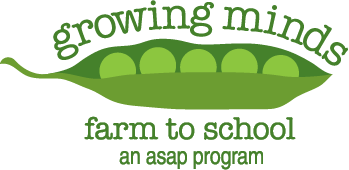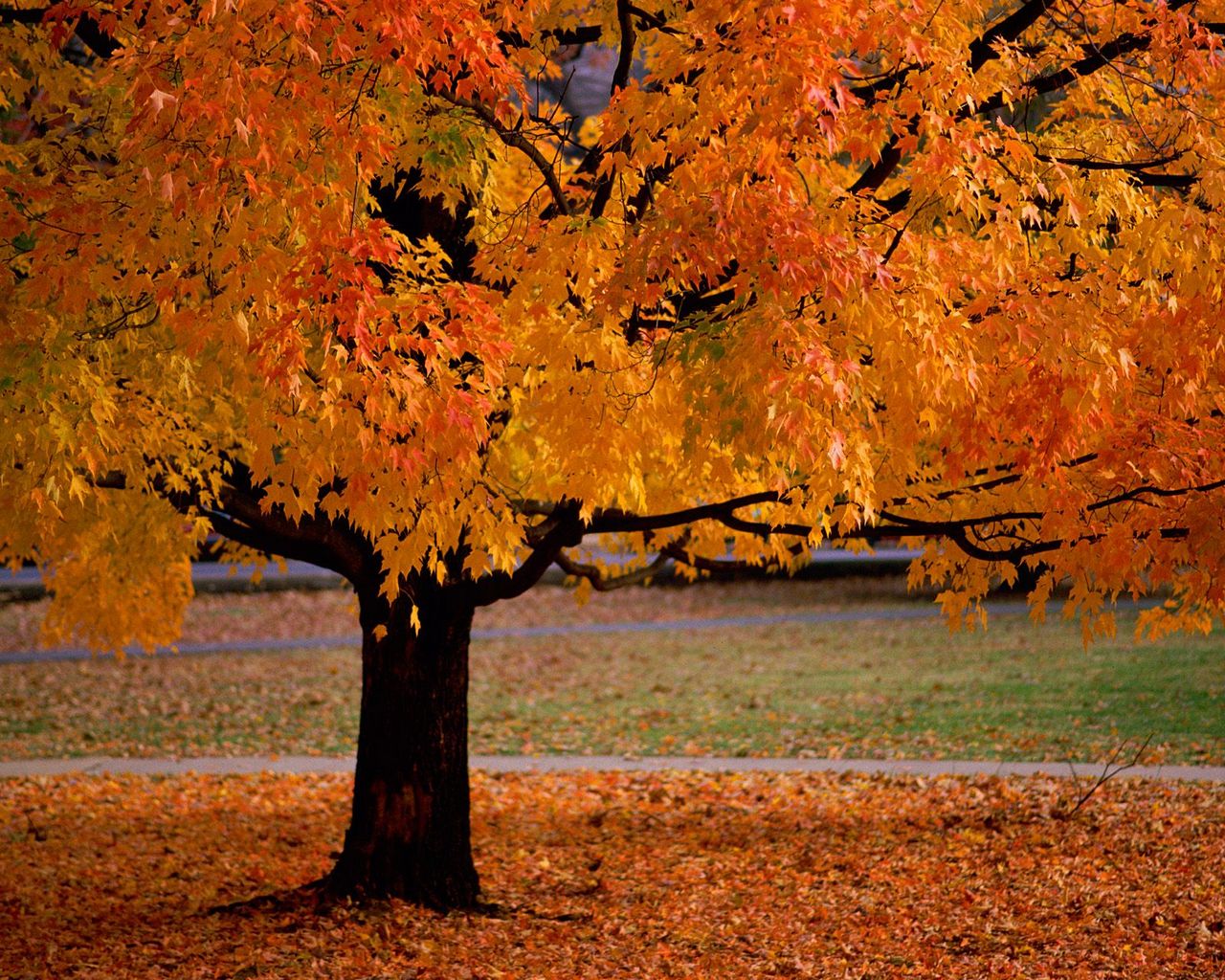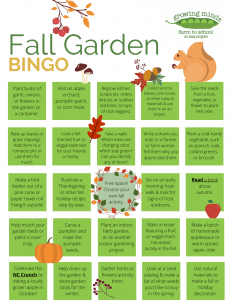This week’s theme is autumn. Our “Growing Minds Day by Day” educational resource lists are designed for families and educators.
With cooler temperatures, an abundance of freshly harvested produce available from local farms, and many observable changes happening in the natural world and the garden, autumn is a wonderful time of year to get kids learning and exploring outdoors. We hope the resources below will inspire you to engage in farm to school (or home!) activities with your students or kids this fall.
Books:
Reading one of the books below can earn kids a square on our Fall Bingo card!
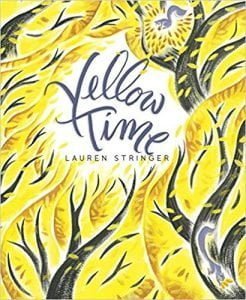 Yellow Time
Yellow Time
In this story by author/illustrator Lauren Stringer, children and animals alike excitedly anticipate yellow time, when the trees release their colorful leaves to blanket the earth, crows raise their voices joyfully from the bare branches, and squirrels busy themselves preparing their nests for winter. This lyrical celebration of the beauty and fun of autumn is sure to become a perennial fall favorite. Recommended for grades preschool through 3rd. Watch a librarian-led read aloud on YouTube.
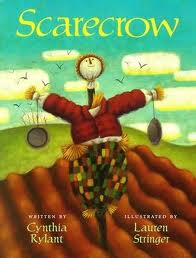 Scarecrow
Scarecrow
This book, written by Cynthia Rylant and illustrated by Lauren Stringer, examines the life of a scarecrow, taking the reader from its construction to its daily activities like interacting with garden creatures. The scarecrow shows great patience and perseverance, and we see how valuable those traits can be for a gardener. Children will enjoy watching the gardening process through the eyes of the friendly scarecrow. Recommended for grades preschool through 3rd. Watch a read aloud on YouTube.
Find more books
Both of the books above are available for Asheville-based educators to check out from our lending library. Visit the Growing Minds’ farm to school literature database to discover more of our favorite fall-themed children’s books.
Local Food Recipes:
 Fall means that apple season is in full swing in Western North Carolina! Did you know that Henderson County is one of the leading producers of apples in the nation? There are over 15 varieties of apples grown commercially locally, ranging in color from dark red and pink, to yellow and green. There are many more varieties of Heirloom apples. Some apples taste sweet, while others are tart.
Fall means that apple season is in full swing in Western North Carolina! Did you know that Henderson County is one of the leading producers of apples in the nation? There are over 15 varieties of apples grown commercially locally, ranging in color from dark red and pink, to yellow and green. There are many more varieties of Heirloom apples. Some apples taste sweet, while others are tart.
Use ASAP’s online Local Food Guide to search for apple orchards in the Appalachian Grown region that accept visitors for u-pick or other fall activities like corn mazes and pumpkin patches.
Today we’re sharing two simple recipes that highlight this famous fall fruit. Kids who help prepare either of the recipes below can earn a square on our Fall Bingo card!
Warm Apple Punch
Makes 8 8 oz. servings
Ingredients:
- 1/2 gallon local apple cider
- Orange slices
- 1-2 cinnamon sticks
Directions:
- Place all ingredients in a large pot.
- Cook on low heat for 20 minutes or until heated through, stirring occasionally. Do not boil.
- Remove cinnamon sticks and serve warm. Enjoy!
Crock Pot Chunky Applesauce
Serves 4-6
Ingredients:
- 6 medium local apples (use a mix of varieties for a unique flavor)
- 1/3 cup water
- 1/2 cup sugar
- 3/4 tsp. cinnamon
Directions:
- Have an adult peel and cut the apples into chunks.
- Place the apple chunks in a crock pot.
- Children can add the water, sugar, and cinnamon to the apples and stir together.
- Cover and cook on low for 8 hours.
Educational Resources:
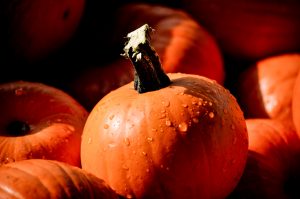 Growing Minds Resources
Growing Minds Resources
- This Week in the Garden Activity Guides
- Seasons on a Farm (K-2): Students will learn about seasonal weather patterns and their effects on local farms and gardens and use qualitative and quantitative measurements to describe weather.
- Changing Leaves and Changing Seasons (K-2): Teach students about changing seasons and the season of autumn. Students create a leaf spinner and record daily temperatures.
- Pumpkin Exploration (K-2): Introduce students to pumpkins and how they grow. Use a pumpkin seed activity to practice sorting and counting in 2s, 5s, and 10s.
- Sweet Potato Applesauce (K-2): A no-heat recipe that features local apples and sweet potatoes, with literature and curriculum connections.
- Harvesting the Garden (K-2): Students will review characteristics of mature produce and learn how to harvest different types of fruits and vegetables. As a class, students will make harvesting calendars and apply their harvesting skills in the garden.
- Eating in Season (3-5): Guide students in using scientific inquiry to design a seasonal taste test and investigate what produce is grown nearby seasonally, if locally grown foods tastes better, and what other factors might play a role in flavor. Groups will graph and summarize results and the class has the opportunity to discuss benefits of seasonal meal planning and eating locally grown products.
- An Apple a Day (3-5): Students learn about different varieties of apples, make apple juice, and devise their own methods of extracting juice.
Activities:
 Leaf Exploration
Leaf Exploration
Take children to the garden and focus on leaves. Point out different leaves on edible plants, flowers, trees, and weeds. How many different leaves can they find? What do they notice about the leaves? Help them identify each leaf with the name of the plant. As an extension, go inside and have the class sort the leaves into baskets by color, shape, or size. Children can then use the leaves to make a collage with paper and glue.
Explore and Save Seeds
Spend a few days collecting seeds from outside (pine cones, berries), everything bagels (poppy, sesame), and fruits and vegetables such as pumpkin, squash, apples, green peppers, tomatoes, lemons, avocados … the list is endless. Once you have a good amount of seeds collected, sort them into different containers or into the compartments of an ice tray. Spend time with your kids investigating the seeds. Examine them through a magnifying glass, feel whether they are hard or squishy, crack open the big ones, and have children guess what food or plant it came from. Do research together on how each grows from seed to plant, and then how it becomes food on the table.
As plants mature they produce seeds. Whether it be lettuce that has bolted and is flowering, or weeds that have gotten very large, plants are “going to seed” throughout the garden during the fall. Historically, farmers have saved seeds. Many resources exist to help teachers and children save seeds for the next growing season. Seed Savers Exchange, an organization dedicated to promoting saving seeds, offers many tips and how-to’s at seedsavers.org.
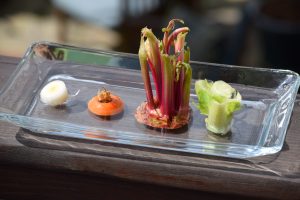 Regrow Your Food Scraps
Regrow Your Food Scraps
Autumn Bingo Did you know you can re-grow some vegetables from food scraps right in your own kitchen? This is a great way to teach your kids about growing food and reusing things to make less waste. Scallions, head lettuce, and celery are good starter scraps to get your little one’s attention right away. Simply place the root ends of the scraps in water, change out the water every other day, and keep in sunlight if possible. You will see small celery stalks and whole ready-to-eat scallions begin to grow within days.
Once you and your child are certified experts at growing scallions, move on to bigger and more challenging projects. Plant the scallion, lettuce, and celery sprouts into small pots of soil to see full growth. Sprout onions, sweet potatoes, ginger, garlic, lemongrass, or even an avocado seed. This activity will show your child how easy, rewarding, and fun gardening can be, as well as teach them about waste management and being resourceful.
 Fall Garden Bingo:
Fall Garden Bingo:
Cap off your week of Autumnal exploration with our Fall Garden bingo game! Use the bingo card below to keep track of your kids’ fall farm to school activities. Kids should check five consecutive boxes in a row, column, or diagonal to win (bonus points for checking all of the boxes!). Most importantly, have fun! Click here to download a printable PDF Bingo Card that has hyperlinks to helpful resources.
Bingo Tips:
- Use the resources shared above (children’s books, recipes, and activities) to complete some of the bingo squares.
- Challenge another class or household to a bingo tournament! Take photos or videos to document each activity square that your students/kids complete, and share them with each other as you play.
- Keep in mind that the activities your child will be able to participate in will depend on their age.
—
That’s it for this week. Check back next week for new resources. Click here to access Day by Day resources from past weeks. If you didn’t find what you’re looking for here, please visit our Lesson Plans page.
